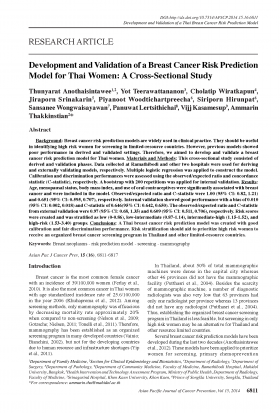This website uses cookies so that we can provide you with the best user experience possible. Cookie information is stored in your browser and performs functions such as recognising you when you return to our website and helping our team to understand which sections of the website you find most interesting and useful.
Development and validation of a breast cancer risk prediction model for thai women: a cross-sectional study. (2014)

Details
Abstract
Background: Breast cancer risk prediction models are widely used in clinical practice. They should be useful in identifying high risk women for screening in limited-resource countries. However, previous models showed
poor performance in derived and validated settings. Therefore, we aimed to develop and validate a breast cancer risk prediction model for Thai women.
Materials and Methods: This cross-sectional study consisted of derived and validation phases. Data collected at Ramathibodi and other two hospitals were used for deriving and externally validating models, respectively. Multiple logistic regression was applied to construct the model. Calibration and discrimination performances were assessed using the observed/expected ratio and concordance statistic (C-statistic), respectively. A bootstrap with 200 repetitions was applied for internal validation.
Results: Age, menopausal status, body mass index, and use of oral contraceptives were significantly associated with breast cancer and were included in the model. Observed/expected ratio and C-statistic were 1.00 (95% CI: 0.82, 1.21) and 0.651 (95% CI: 0.595, 0.707), respectively. Internal validation showed good performance with a bias of 0.010 (95% CI: 0.002, 0.018) and C-statistic of 0.646(95% CI: 0.642, 0.650). The observed/expected ratio and C-statistic from external validation were 0.97 (95% CI: 0.68, 1.35) and 0.609 (95% CI: 0.511, 0.706), respectively. Risk scores were created and was stratified as low (0-0.86), low-intermediate (0.87-1.14), intermediate-high (1.15-1.52), and high-risk (1.53-3.40) groups.
Conclusions: A Thai breast cancer risk prediction model was created with good calibration and fair discrimination performance. Risk stratification should aid to prioritize high risk women to receive an organized breast cancer screening program in Thailand and other limited-resource countries.




